A Look Inside NHRA's EV Evolution

Photo courtesy of Chevrolet
As the motoring public warms up to electric vehicles and automakers continue to invest billions in their development, the drag race sanctioning body seeks to establish an open dialogue with OEMs, parts suppliers, car builders, and safety equipment manufacturers to chart the best path forward.
Electric vehicle technology has come a long way over the past decade. If countless YouTube videos of Teslas putting the hurt on Hellcats at the drag strip weren’t enough, consider the fact that last year, veteran racer Steve Huff became the first to break the 200 mph barrier in a four-wheeled EV, posting an ET of 7.52 at 201.07 mph at Tucson Dragway in the Huff Motorsports electric dragster.
“Big Daddy” Don Garlits, who has been campaigning an electric dragster of his own in recent years, had previously posited that hitting 200 wasn’t possible with currently available technology. In the spirit of competition, Huff set out to prove Garlits wrong, and he’s already set his sights on another milestone. “We’re going out to be the first in the 6.00s,” he said in an interview with Drag Illustrated. “I have the utmost confidence that will happen.”
As electric vehicles continue their rapid evolution, and car counts increase at drag racing events in the coming years, the NHRA has created a forum for equipment suppliers, car builders, and OEMs to collaborate on various EV-related matters through a series of panel discussions, the first of which took place at the Gatornationals at Gainesville Raceway this past March. The topics at these meetings are expected to be wide-ranging, but ultimately the goal is to allow EVs to be effectively integrated into NHRA’s existing formats without encroaching on the current platform.
“Our tagline is ‘Speed for All,’ and this is very much in line with our mission of providing an accommodating environment for all competitors and a wide variety of vehicles,” said Ned Walliser of the NHRA. “We really wanted to get everyone together and gather as much information as we could to see what we can build off of. We currently have EV racing rules in our NHRA rulebook—we race them in ET bracket as well as the Junior Drag Racing League side—so electric is part of our program already, and we see the evolution of electric racing in place. There’s a big push for it now, so we really need to investigate where we have synergies with the OEMs as well as the manufacturers of safety equipment that can help expand electric racing to multiple levels of the sport.”

Walliser explained that the NHRA understands where the technology is headed on the OEM side and that they’re seeing a strong desire for EVs to have their own category within the organization, but the design of such a category has yet to be determined. “Is it an OEM category or is it a purpose-built EV race class?” he said. “And if it’s a purpose-built race car, what can we learn from each other in order to have the best possible program here?”
The symbiotic relationship between automakers and motorsports has been an intrinsic part of automotive development since the dawn of motoring, with OEMs taking to the track in order to test their designs and identify where performance and durability improvements can be made. It’s a process that not only improves the race cars, but also technologies that will eventually find their way into an automaker’s street-driven production vehicles. Yet because of the inherent nature of EV technology the script has been flipped in some ways, as research and development at the OEM level has largely focused on road car applications. So, as EVs are gradually integrated into previously established race formats, sanctioning bodies like the NHRA are focused on ensuring that aspects of this development that could potentially impact motorsports efforts don’t go unnoticed.
“We want to make sure that the direction that we’re going is the same direction that the OEMs are going,” Walliser told us. “And we expect that the OEMs will learn from some of the things that we are doing at the race track as well.”
And much of this information sharing revolves around issues of safety. He cited the discrepancies in weight between EVs and traditional ICE vehicles, and how that may affect equipment rules going forward, as a particular area of interest at this initial meeting. “We obviously have chassis specifications, and those specifications are developed by the speed and weight of the car as well as how that car is built by the OEM. From there we develop a roll cage or roll bar system inside the car to protect the driver in case of an incident based on that information. But with the added weight of the batteries in an EV, we want to review those specifications and make sure that we are providing the best safety we can for a given category.”
Walliser is adamant that this increased interest in EV development by NHRA is not designed to overtake any existing categories and noted that it may present opportunities to usher in improvements across the board. “When you’re talking about the safety, you can learn from every situation and scenario, and I don’t think that what we learn from EV racing will be any different in that regard. We will learn some things along the way, and safety among all of the NHRA series will continue to evolve,” he explained.
 MEMBERSHIP LOGIN
MEMBERSHIP LOGIN JOIN PRI
JOIN PRI


